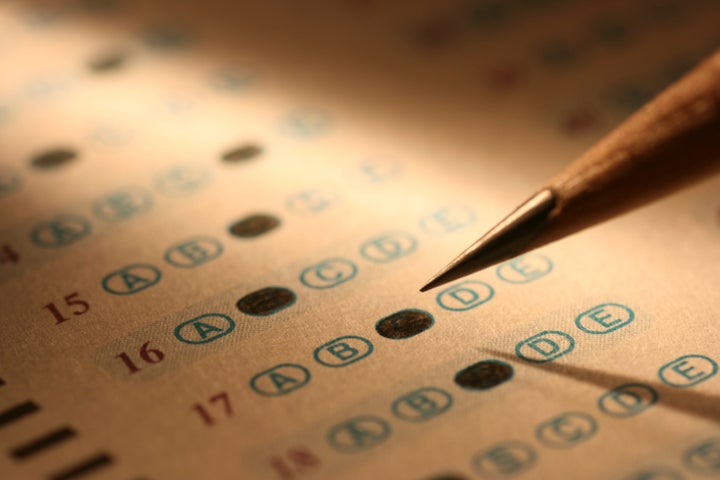
The dreadful, horrifying 8 a.m.: the time when millions of high school juniors and seniors go to high schools around America to take the SAT. Tired, caffeine-addicted teens take the SAT in hopes that the score will give them acceptance to their dream college. The students start their test and begin bubbling in their scantrons. One question at a time, students frantically answer as many questions as they can. Several students stop and ponder the countless number of questions. Others don’t think; they guess. “5 minutes left.” The sound of the students frantically trying to bubble in their answer, double-checking their answers, the sound of kids trying to survive the cut to get into the best college surrounds the room; it is this sound that makes millions of young
Americans anxious about whether they get into a good college, will have a good-paying job or even be competent enough. The sound is you, your score; it is your score that determines your future and fate. The SAT is one of the most important tests that most Americans take in their lifetime. It is an entrance exam used by most colleges and universities to make admissions decisions, to give special individuals their coveted acceptance letter in the mail. It determines aspects of our everyday lives: the ranking of high schools and colleges, the housing market and the indication of a “good school district,” the determination of whether a student will be competent in his or her first year of college or even his or her future. The standardized test has played a very important role in our lives, especially for our education system. The test has changed a lot over the past few years. Before, the test was out of 2400, a lauded score that few students could ever achieve in their high school careers. The test procedures changed significantly, in that, each wrong answer doesn’t penalize you, and you can earn a score up to 1600, a score similar to the SAT version up to 2005. The test takes three hours with a writing section, an optional section in the SAT that most universities and colleges require students to take in order to apply for that college. The SAT has become one of the most important standardized tests in America; however, it gives the disadvantaged an unfair chance at getting into a college and to earn quality education. Many critics disparage the SAT for its material, bias and racism in the test content. Studies have shown that the material inside the SAT might affect students’ scores by the wording of the problems and the various cultural interpretations of words. Thus, it is necessary to address issues that arise from standardized testing, such as the built-in bias, which results in several groups scoring lower than others, and the limited opportunities for higher education that results from testing.
There are many problems with the SAT that affect students of different backgrounds such as cultural and income bias. These problems are critical to a student’s future in that they can potentially impact college admissions, potential scholarships and jobs. The article, The SAT and Admission: Racial Bias and Economic Inequality by Ethan Biamonte, gives an overview of how colleges implement the SAT into their application process and how it is “unethical for the SAT to be used in college admission because it has cultural and economic biases that oppress low-income groups, racial minorities and females.” Biamonte believes that the SAT has different kinds of biases that affect many groups of people. For example, he presents evidence that there is such economic bias in the SAT, given that, as the numerical value of family income increases, the test scores of three different SAT sections go up as well, suggesting a correlation between family wealth and educational success. It doesn’t necessarily mean that being rich would automatically give you a higher score, but that the concept of money that can buy coaching programs, which help the child to get a good SAT score. The income bias is to reflect the ability to have a tutor access to many test-preparation books available in the market today. Furthermore, we must consider that income bias should also reflect the ability to buy test-preparation books and online services that offer SAT guides and lessons, which are costly to certain individuals.
But it is not only income bias that increases the score gap disparity affecting the millions of low-income, underprivileged students who are trying to change their future for the better, but also gender bias that encourages the score gap disparity. Biamonte suggests that there is gender bias because “females with similar ability levels to males tend to perform worse than males on the math section of the test.” He concludes that “females’ abilities are underestimated.” However, why do females tend to underperform males? One possible explanation for this is that “females are less confident in their answers.” In a study, Ellen Lenney claims that women “display lower self-confidence than men across almost all achievement situations” and double-checking answers on the SAT gives a significant disadvantage, as women are more likely to doubt their answer with the time putting pressure on them. This and many other cases of biasness are crucial in a way that they show us the disparity of the SAT, the reliance of the admission tests and the effects of the disadvantaged. College has become the way to the path of success and with admission test as a barrier to the disadvantage, it tells us something about life and America: not everything is fair or equal.
In the future, we must find a way to solve this disparate problem that is affecting America greatly. It has been a big problem for many students to get into the college of their choice, to be closer to fulfilling their dreams, to become successful one day as well as to innovate the world for the better. The test is treated as a barrier for many low-income, minority students who cannot afford the $54 SAT test and test-preparation materials. It is treated as a restriction for students of a different culture who have different interpretations of words. It is treated as a limitation to the many diverse ethnicities, backgrounds to get that high score they need to go to college. Thus,America’s education system is in a critical and crucial position. A reform must take place to educate our society for the better, in order to flourish with academia all around. It is the path towards success and we must continue the generational trend of influencing students to go to college and pursuing their dreams, the American Dream. We cannot wait. In order to make a better place and a better future, we must act now before it’s too late.
